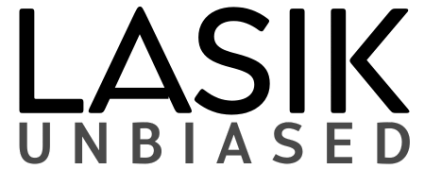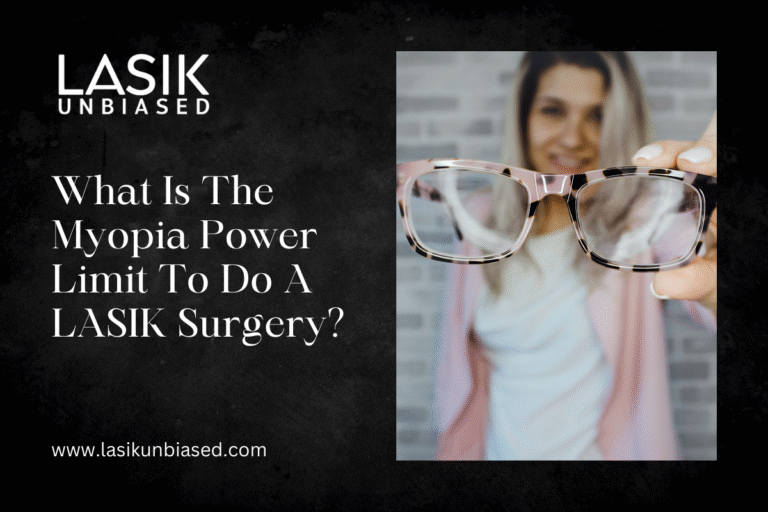The general myopia power limit for LASIK surgery is around -8.00 to -12.00 dioptres (D), depending on corneal thickness and individual suitability.
Patients outside this range may need to explore alternative corrective options.
Understanding the limits for LASIK surgery involves analysing specific factors related to myopia, corneal health, and advancements in technology. This blog will provide valuable insights into determining eligibility for LASIK based on myopia levels and help you understand how surgeons decide on treatment options.
What Determines Myopia Limits for LASIK Surgery?
LASIK, or Laser-Assisted in Situ Keratomileusis, reshapes the cornea to correct refractive errors such as myopia (nearsightedness). One of the critical parameters determining eligibility is the degree of myopia in dioptres, also referred to as refractive error.
Several key factors define the measurable limit for myopia in LASIK surgery, including corneal thickness, pupil size, and the stability of the patient’s myopia. Generally, lower levels of myopia (-1.00 D to -6.00 D) are ideal for LASIK, while higher ranges require detailed evaluation.
Corneal Thickness Assessment
Corneal thickness is vital in determining whether a patient’s eye can undergo laser reshaping. During LASIK, a portion of the corneal tissue is ablated to reduce refractive errors. If the cornea is too thin, removing additional layers to correct high myopia may compromise corneal strength, leading to complications such as ectasia. The risk of ectasia can be mitigated with proper screening and advanced diagnostic tools.
Standard practice dictates maintaining a residual corneal thickness of at least 250-300 microns post-surgery. Patients with higher myopia (above -8.00 D) may require significant corneal reshaping, making them less suitable for LASIK.
Stability of Myopia Levels
Another crucial condition is stable refractive power for at least one to two years before surgery. Fluctuating myopia levels can render LASIK ineffective as the changes invalidate the correction made during surgery. Patients with progressive myopia are usually advised to wait until their vision stabilises.
Pupil Size Considerations
Large pupils can increase the risk of post-surgical issues, such as glare and halos. While not a direct determinant of myopia limits, pupil size is factored into the overall assessment to ensure patient safety and optimal post-surgery outcomes.
Advanced Diagnostic Tools
Modern clinics often use corneal topography (mapping), tomography, and wavefront analysis for precise evaluation. These tools assess the topography and thickness of the cornea, helping surgeons decide whether correcting high myopia is feasible without complications.
LASIK Technology and How it Affects Myopia Limits
Advances in LASIK technology have expanded the scope of treatment. While the earlier versions of this procedure capped effectiveness at lower myopia levels, recent innovations allow for the safe correction of higher prescriptions.
Standard LASIK vs. Custom LASIK
Standard LASIK works best for moderate myopia (-1.00 D to -6.00 D). Custom LASIK, which employs wavefront-guided technology, addresses unique refractive errors and irregularities, extending eligibility for higher myopia levels up to -12.00 D.
Contoura Vision (Topography-Guided LASIK)
This advanced technique maps the cornea with extreme precision, correcting irregularities in shape. Patients with myopia levels exceeding standard limits may benefit from this approach, provided they meet corneal thickness requirements.
SMILE and PRK as Alternatives
For patients exceeding LASIK’s power limit or unsuitable due to corneal thickness, procedures such as Small Incision Lenticule Extraction (SMILE) and Photorefractive Keratectomy (PRK) offer viable alternatives. These methods involve different approaches to reshape the cornea, extending the options for individuals with higher myopic prescriptions.
Why Myopia Power Limits Are Essential for LASIK?
Setting clear limits is crucial to ensure both the safety and effectiveness of LASIK surgery. Exceeding the advised dioptre range increases the risk of complications, including under-correction, over-correction, or post-operative issues like dry eye or halo effects.
Minimising the Risk of Ectasia
One of the most severe complications associated with LASIK is corneal ectasia, a condition where the cornea becomes progressively thinned and distorted. Staying within myopia limits reduces the likelihood of removing excessive corneal tissue, which can destabilise the eye’s structure.
Achieving Optimal Results
Patients within the accepted power range tend to experience the best outcomes. This ensures that corrective surgery improves visual acuity significantly without overcompensating or leaving residual refractive errors.
Enhanced Safety in Long-Term Vision Stability
Adhering to limits safeguards long-term vision stability, reducing the possibility of regression (return of myopia) after surgery. Outcomes for patients within recommended ranges are more predictable and reliable than for those with extreme prescriptions.
What are the Alternatives for Patients Beyond LASIK Limits?
Patients with extreme myopia often require alternative methods when their power exceeds LASIK thresholds. Fortunately, there are several effective options for improving vision and quality of life without compromising safety.
Implantable Collamer Lenses (ICL)
For individuals with myopia beyond -12.00 D, ICL is a suitable choice. ICLs are implanted in the eye without altering the corneal structure, making the procedure reversible and ideal for high refractive errors.
Refractive Lens Exchange (RLE)
RLE is commonly employed for excessive prescriptions or conditions like cataracts. This procedure involves replacing the eye’s natural lens with an artificial intraocular lens (IOL) to correct vision comprehensively.
Orthokeratology
For non-surgical correction, orthokeratology (ortho-k) is an option. Specialised contact lenses reshape the cornea overnight, providing temporary improvement during daytime.
Note: Orthokeratology typically works best for mild to moderate myopia and can only provide temporary correction. It may not be suitable for high myopia or those seeking permanent vision correction.
Regular Eyewear or Contact Lenses
If surgery is not an option, advanced lightweight glasses and contact lenses offer exceptional clarity for managing high myopia. Innovations in lens design, including high-index materials, minimise thickness and weight despite strong prescriptions.
The Role of Consultation in Determining LASIK Eligibility
Before proceeding with LASIK or any alternative treatment, a comprehensive consultation with a qualified ophthalmologist is essential. Customised evaluations help identify the most appropriate approach based on individual eye anatomy and prescription.
What to Expect in a Consultation?
- Comprehensive Eye Exam: Includes corneal mapping, thickness measurement, and assessment of refractive power.
- Medical History Review: Addresses factors like age, systemic conditions, and medication usage.
- Discussion of Goals and Expectations: Sets realistic post-surgery outcomes and alternatives if LASIK isn’t suitable.
Consulting experienced surgeons ensure clarity around risks and rewards, empowering patients to make informed decisions.
Can Lifestyle Choices Influence Surgical Suitability?
Maintaining good eye health plays a supportive role in determining LASIK eligibility. For instance, individuals with dry eye syndrome may face challenges during recovery. Boosting hydration and proper eye care in the months prior can positively impact surgical outcomes.
Tips for Supporting Your LASIK Candidacy
- Avoid excessive screen time before evaluation to minimise dry eyes.
- Maintain proper sleep schedules to prevent ocular stress.
- Use prescribed eye lubricants and nutritional supplements if necessary.
Key Takeaways for LASIK and Myopia Power Limits
The myopia power limit ranges for LASIK surgery have become more accommodating due to technological advancements, with current standards allowing correction up to -12.00 D. Factors such as corneal thickness, pupil size, and stable refractive power govern individual suitability.
For those beyond LASIK’s eligibility range, alternative procedures like ICL, RLE, or non-invasive options ensure that clear vision remains within reach. The key to success lies in detailed consultations, advanced diagnostic evaluations, and transparent discussions with healthcare providers.
Your Next Step Toward Clearer Vision
Now that you understand the key considerations around LASIK’s myopia power limits, it’s time for action. Schedule a consultation with an eye care specialist to evaluate your options and explore a vision correction solution tailored to your needs.


